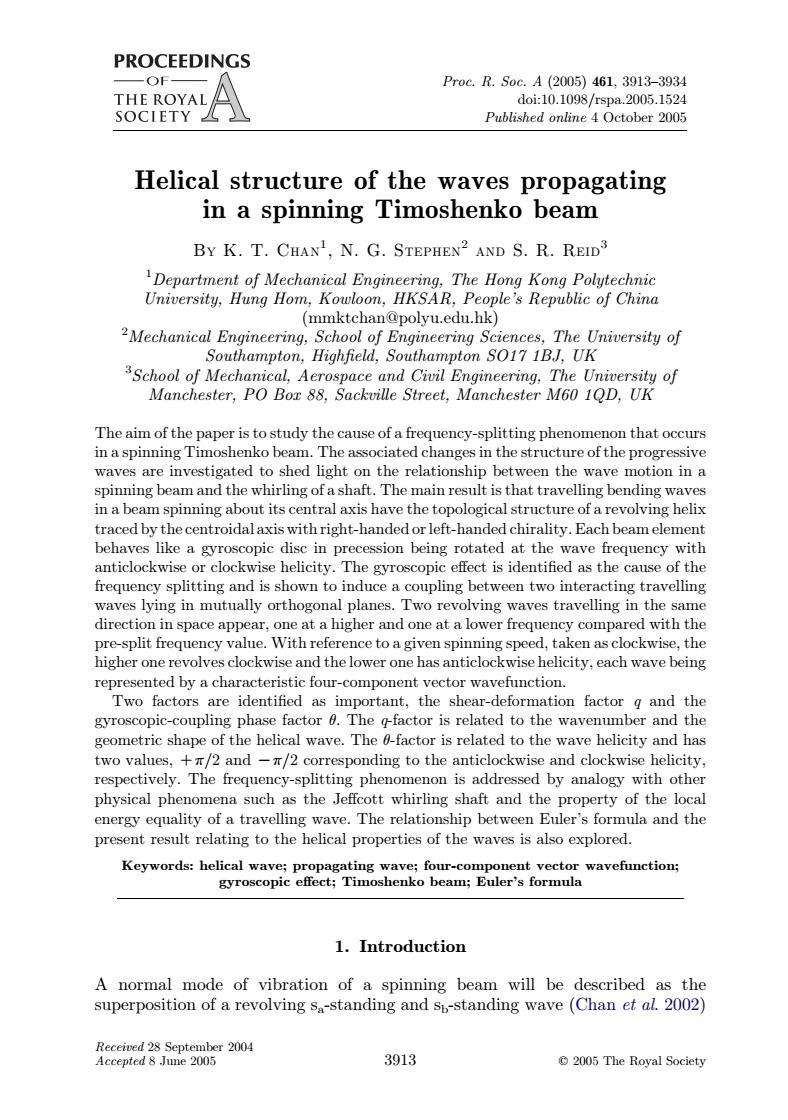正在加载图片...

PROCEEDINGS -OF- Proc.R.Soc.A(2005)461,3913-3934 THE ROYAL doi:10.1098/rspa.2005.1524 SOCIETY Published online 4 October 2005 Helical structure of the waves propagating in a spinning Timoshenko beam BY K.T.CHAN,N.G.STEPHEN2 AND S.R.REID3 Department of Mechanical Engineering,The Hong Kong Polytechnic University,Hung Hom,Kowloon,HKSAR,People's Republic of China (mmktchan@polyu.edu.hk) 2Mechanical Engineering,School of Engineering Sciences,The University of Southampton,Highfield,Southampton SO17 1BJ,UK 3School of Mechanical,Aerospace and Civil Engineering,The University of Manchester,PO Bor 88,Sackville Street,Manchester M60 1QD,UK The aim of the paper is to study the cause of a frequency-splitting phenomenon that occurs in a spinning Timoshenko beam.The associated changes in the structure of the progressive waves are investigated to shed light on the relationship between the wave motion in a spinning beam and the whirling of a shaft.The main result is that travelling bending waves in a beam spinning about its central axis have the topological structure of a revolving helix traced by the centroidal axis with right-handed or left-handed chirality.Each beam element behaves like a gyroscopic disc in precession being rotated at the wave frequency with anticlockwise or clockwise helicity.The gyroscopic effect is identified as the cause of the frequency splitting and is shown to induce a coupling between two interacting travelling waves lying in mutually orthogonal planes.Two revolving waves travelling in the same direction in space appear,one at a higher and one at a lower frequency compared with the pre-split frequency value.With reference to a given spinning speed,taken as clockwise,the higher one revolves clockwise and the lower one has anticlockwise helicity,each wave being represented by a characteristic four-component vector wavefunction. Two factors are identified as important,the shear-deformation factor g and the gyroscopic-coupling phase factor 0.The q-factor is related to the wavenumber and the geometric shape of the helical wave.The 0-factor is related to the wave helicity and has two values,+/2 and-m/2 corresponding to the anticlockwise and clockwise helicity, respectively.The frequency-splitting phenomenon is addressed by analogy with other physical phenomena such as the Jeffcott whirling shaft and the property of the local energy equality of a travelling wave.The relationship between Euler's formula and the present result relating to the helical properties of the waves is also explored. Keywords:helical wave;propagating wave;four-component vector wavefunction; gyroscopic effect;Timoshenko beam;Euler's formula 1.Introduction A normal mode of vibration of a spinning beam will be described as the superposition of a revolving sa-standing and su-standing wave (Chan et al.2002) Received 28 September 2004 Accepted 8 June 2005 3913 2005 The Royal SocietyHelical structure of the waves propagating in a spinning Timoshenko beam BY K. T. CHAN1 , N. G. STEPHEN2 AND S. R. REID3 1 Department of Mechanical Engineering, The Hong Kong Polytechnic University, Hung Hom, Kowloon, HKSAR, People’s Republic of China (mmktchan@polyu.edu.hk) 2 Mechanical Engineering, School of Engineering Sciences, The University of Southampton, Highfield, Southampton SO17 1BJ, UK 3 School of Mechanical, Aerospace and Civil Engineering, The University of Manchester, PO Box 88, Sackville Street, Manchester M60 1QD, UK The aim of the paper is to study the cause of a frequency-splitting phenomenon that occurs in a spinning Timoshenko beam. The associated changes in the structure of the progressive waves are investigated to shed light on the relationship between the wave motion in a spinning beam and the whirling of a shaft. The main result is that travelling bending waves in a beam spinning about its central axis have the topological structure of a revolving helix traced by the centroidal axis with right-handed or left-handed chirality. Each beam element behaves like a gyroscopic disc in precession being rotated at the wave frequency with anticlockwise or clockwise helicity. The gyroscopic effect is identified as the cause of the frequency splitting and is shown to induce a coupling between two interacting travelling waves lying in mutually orthogonal planes. Two revolving waves travelling in the same direction in space appear, one at a higher and one at a lower frequency compared with the pre-split frequency value. With reference to a given spinning speed, taken as clockwise, the higher one revolves clockwise and the lower one has anticlockwise helicity, each wave being represented by a characteristic four-component vector wavefunction. Two factors are identified as important, the shear-deformation factor q and the gyroscopic-coupling phase factor q. The q-factor is related to the wavenumber and the geometric shape of the helical wave. The q-factor is related to the wave helicity and has two values, Cp/2 and Kp/2 corresponding to the anticlockwise and clockwise helicity, respectively. The frequency-splitting phenomenon is addressed by analogy with other physical phenomena such as the Jeffcott whirling shaft and the property of the local energy equality of a travelling wave. The relationship between Euler’s formula and the present result relating to the helical properties of the waves is also explored. Keywords: helical wave; propagating wave; four-component vector wavefunction; gyroscopic effect; Timoshenko beam; Euler’s formula 1. Introduction A normal mode of vibration of a spinning beam will be described as the superposition of a revolving sa-standing and sb-standing wave (Chan et al. 2002) Proc. R. Soc. A (2005) 461, 3913–3934 doi:10.1098/rspa.2005.1524 Published online 4 October 2005 Received 28 September 2004 Accepted 8 June 2005 3913 q 2005 The Royal Society